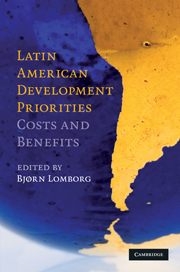Book contents
- Frontmatter
- Contents
- List of figures
- List of tables
- List of contributors
- Acknowledgments
- Abbreviations and acronyms
- Expert panel findings
- Introduction
- Democracy
- Education
- Employment and social security
- Environment
- 4 Forests, biodiversity, and avoided deforestation in the LAC region
- 4.1 Forests and biodiversity: an alternative view
- Fiscal problems
- Health
- Infrastructure
- Poverty
- Public administration
- Violence and crime
- Conclusion
4 - Forests, biodiversity, and avoided deforestation in the LAC region
Published online by Cambridge University Press: 05 June 2012
- Frontmatter
- Contents
- List of figures
- List of tables
- List of contributors
- Acknowledgments
- Abbreviations and acronyms
- Expert panel findings
- Introduction
- Democracy
- Education
- Employment and social security
- Environment
- 4 Forests, biodiversity, and avoided deforestation in the LAC region
- 4.1 Forests and biodiversity: an alternative view
- Fiscal problems
- Health
- Infrastructure
- Poverty
- Public administration
- Violence and crime
- Conclusion
Summary
Introduction
The purpose of this chapter is to provide an overview of the benefits of forests and biodiversity in the LAC region and to move toward the selection of cost-effective solutions for the protection of these resources. It draws from the literature to describe the situation with forests and biodiversity, both generally and within the context of the region. The various techniques for estimating the value of biodiversity are particularly subtle and are developed at some length. The value of the benefits of forests and biodiversity and the costs of protection are identified and drawn from the literature. Utilizing these data, a number of CBAs are developed and some possible “solutions” posited. It is noted that the literature related to the costs and benefits of forests and biodiversity is poorly developed for many values and much of the world. Despite these limitations, the solutions are assessed, their strengths and weaknesses noted, and a preferred solution selected. Since some of the selections are built on contentious numbers from the literature and for cost systems that are not fully developed, the choice of solution considers questions of data reliability and completeness, as well as BCRs.
A rationale for the importance of Latin American biodiversity can be found in the Inter-American Development Bank's survey that found “environment” one of the “challenges” facing the region. In the environment category, deforestation (81.5%) and loss of biodiversity (73.2%) were the top two concerns.
- Type
- Chapter
- Information
- Latin American Development PrioritiesCosts and Benefits, pp. 163 - 226Publisher: Cambridge University PressPrint publication year: 2010



